I'm currently learning the basics of radio and have noticed that some radios, such as crystal radios, have a monopole antenna that is essentially a wire buried in the ground. However, other radios, such as the portable one sitting on my desk, do not. Do antennas need to be grounded?
2 Answers
Apologies for the long answer - its a complicated subject. I've tried to focus on the main points. Its not meant to be a comprehensive treatment of aerials.
Ground and Earth.
If by 'ground' you mean physically connected to the Earth then the answer is plainly no, otherwise communications satellites or space probes wouldn't work. If by 'ground' you mean a point in the circuit that all other voltages in a circuit are referenced to (0V), then the answer is yes.
Aerials work by transmitting or receiving an electromagnetic wave. (See Maxwell, Hertz, et. al)
The EM wave - aerial types and shapes:
EM Waves can be detected from their electric field or their magnetic field (or both). The wave can also be polarized so aerials can be optimized for this polarization as well. The 'gain' of an aerial can be increased by making it directional, adding extra elements to it or using shaped reflectors. Hence the wide variety of shapes and sizes and plain wacky looking designs to optimize reception (or transmission) at different wavelengths.

The 'simple' monopole.
A vertical aerial (the one commonly used with a crystal set) detects the electric field. This moves charge 'up and down' the aerial producing a small but measurable alternating current. The effect is greatest when the physical dimensions of the aerial match the wavelength of the EM wave. (see resonance effects) It does not require that the aerial is connected to anything.
This type of aerial is omni-directional.
Coupling the (weak) signal to the receiver requires tuning and impedance matching. For a aerial this is performed with the LC tuned circuit (Tank). The tuned circuit will magnify one selected narrow frequency band ( see Q factor). The tuning coil can be tapped (as in an auto transformer) or a separate coil can be used to optimize the loading on the aerial as some of the energy is transferred to the 'radio' circuit. Taking too much energy would damp the response. Keeping a high Q factor allows you to easily separate individual transmissions. (Selectivity)
To maximize this effect the length of the aerial should be related to the wavelength of the signal. The ground (earth) acts as a reflective surface (not as a return conductor) and can double the effective length of the aerial, producing a dipole aerial. This ground plane effect can be improved by using a sheet of metal (good conductor) or even wire.

The common yagi array (TV aerial) demonstrates this idea. The signal is taken from a folded dipole. The other elements are dipoles (horizontally or vertically polarized or both). These act as passive aerials and retransmit the incoming wave with a phase shift so that the add to the signal strength at the main receiving aerial. The yagi is sensitive to direction.

Portable Radios.
The aerial pick up in a a portable radio is a coil wrapped around a ferrite bar. ( a loop aerial) and detects the magnetic field component of the EM wave. This changing magnetic field induces a voltage in the coil. The coil forms a tuned circuit with a variable capacitor. A second 'output' coil or perhaps a 'tap' on the primary coil impedance matches the amplifier circuit without loading the tuned circuit, producing a sharply tuned aerial.
Loop aerials are very directional as you will easily observe by rotating the portable radio through 360 degrees.

Note that one end of the tuned circuit is connected to the 'ground' or 0V of the rest of the radio circuit. You could also add a second aerial (a length of wire or 'whip' aerial) usually connected by a small capacitor to the 'hot' end of the coil or perhaps a separate coil on the ferrite bar. This pulls in the electric field component of the signal and improves reception.
- 18,926
- 30
- 40
-
1Oh, so when you bury one end of a crystal radio's antenna, you are providing a ground plane, not a return path for the current? Would it be possible to make a "floating" crystal radio with an antenna a full wavelength long? – Stephen Melvin Jul 30 '13 at 17:38
-
1@StephenMelvin Yes. The actual antenna is the bit above ground that is separated from the ground through the tuned circuit or pick up coil. Most crystal sets are aimed at the long and medium wave bands because these use high power transmitters so enough energy can be extracted from the signal to operate the headset. Unfortunately the wavelengths are also very long (2000m - 160m) so the shortest quarter wavelength aerial would be about 40m - that's a very long piece of wire so most antennas are very much shorter than the optimum. Look at http://www.techlib.com/electronics/allband.htm – JIm Dearden Jul 30 '13 at 17:59
-
3You mentioned that some antennas detect the electric comp, while some antennas detect the magnetic comp of an EM wave. I understand that the two components of the EM wave are orthogonal to each other, does that come into play when designing an antenna? It seems electric-detecting antenna are often linear lengths of wire, while magnetic-detecting antenna are inductor coils. What is it about these shapes that makes them better suited for picking up a certain component? (It's been a year or two since I earned my BS in Physics so excuse my ignorance if I seem to be missing something obvious.) – Stephen Melvin Jul 31 '13 at 20:12
-
2@StephenMelvin Yes the signals are orthogonal **and** 90 degrees out of phase but unless the wave is plane polarized the electric field could be in all directions and so would be their corresponding magnetic fields so its impossible to draw a simple diagram. The electric field accelerates charge **along the length of a wire** (as if it were connected to an ac source) - hence electric fields are detected by wires, rods etc. The magnetic component uses the transformer effect (see Faraday-Lenz law) to induce a voltage in a conductor **perpendicular** to the field. (cutting conductor). – JIm Dearden Jul 31 '13 at 20:56
-
'scuse me for being late to the party but am I right in saying that a ground isn't needed, but it will improve radiation AND reception? – Steve Jan 17 '17 at 21:53
Portable radios used to have ferrite loop antennas - a coil wound around a ferrite core. These antennas do not need a ground, but the coil is directional, so you might have to point the radio in a certain direction to receive a good signal.
Yagi (beam) antennas also do not require ground, but simple long wire antennas (as for your crystal set) do require a ground.
It all depends on the design of the antenna.
- 57,014
- 1
- 48
- 127
-
-
4This more or less repeats the question rather than answering it. – MickeyfAgain_BeforeExitOfSO Jul 29 '13 at 03:54